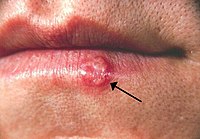
Photo from wikipedia
Background Coagulation abnormalities are common complications of human immunodeficiency virus (HIV) infection. Highly active antiretroviral treatment (HAART) decreased the mortality of HIV but increased coagulopathies. HIV-related thrombocytopenia, prolonged prothrombin time… Click to show full abstract
Background Coagulation abnormalities are common complications of human immunodeficiency virus (HIV) infection. Highly active antiretroviral treatment (HAART) decreased the mortality of HIV but increased coagulopathies. HIV-related thrombocytopenia, prolonged prothrombin time (PT), activated partial thromboplastin time (APTT), and high D-dimer level commonly manifested in patients with HIV. Thus, this study is aimed to compare coagulation parameters of HAART-treated and HAART-naïve HIV-infected patients with HIV-seronegative controls. Methods A systematic literature search was conducted using the databases PubMed/MEDLINE, Embase, Web of Science, and Google Scholar of studies published until July 2021. The primary outcome of interest was determining the pooled mean difference of coagulation parameters between HIV-infected patients and seronegative controls. The Joana Briggs Institute (JBI) critical appraisal tool was used for quality appraisal. Statistical analyses were performed using Stata11.0 software. The statistical results were expressed as the effect measured by standardized mean difference (SMD) with their related 95% confidence interval (CI). Results A total of 7,498 participants (1,144 HAART-naïve patients and 2,270 HAART-treated HIV-infected patients and 3,584 HIV-seronegative controls) from 18 studies were included. HIV-infected patients (both on HAART and HAART-naive) exhibited significantly higher levels of PT than HIV-seronegative controls (SMD = 0.66; 95% CI: 0.53–0.80 and SMD = 1.13; 95% CI: 0.60–2.0, respectively). The value of APTT was significantly higher in patients with HIV on HAART than in seronegative controls. However, the values of PLT count, APTT, and fibrinogen level were significantly higher in seronegative controls. Besides, the level of fibrinogen was significantly higher in HAART-treated than treatment-naïve patients (SMD = 0.32; 95%CI: 0.08, 0.57). Moreover, the level of APTT and PT had no statistical difference between HAART and HAART-naïve HIV-infected patients. Conclusions This study identified that HIV-infected patients are more likely to develop coagulation abnormalities than HIV-seronegative controls. Therefore, coagulation parameters should be assessed regularly to prevent and monitor coagulation disorders in HIV-infected patients.
Journal Title: AIDS Research and Treatment
Year Published: 2022
Link to full text (if available)
Share on Social Media: Sign Up to like & get
recommendations!